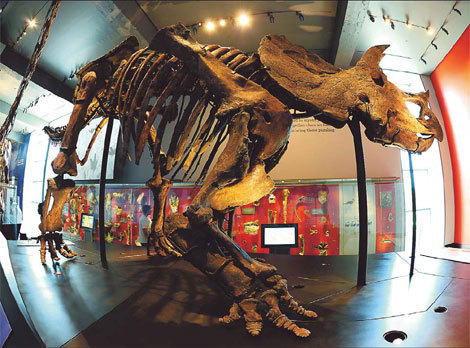Society
Dinosaur find backs meteor theory
Updated: 2011-07-14 07:57
(China Daily)
|
A never-before displayed Triceratops skeleton greets visitors at the new Dinosaur Hall permanent exhibition at the Natural History Museum of Los Angeles. A recent discovery by scientists suggests that dinosaurs were wiped out by a space rock that smashed into Earth. Robyn Beck / Agence France-Presse |
New discovery suggests comet or asteroid led to their extinction
PARIS - Palaeontologists have fired a new salvo in a 30-year-old war of words over the theory that dinosaurs were wiped out by a space rock that smashed into Earth some 65 million years ago.
The hypothesis holds that an asteroid or comet whacked into modern-day Yucatan peninsula, Mexico, igniting massive fires.
Billions of tons of wind-borne ash and dust filtered out light from the Sun, triggering a "nuclear winter" that cooled the planet and withered the vegetation on which dinosaurs directly or indirectly depended.
After a reign that had lasted more than 150 million years, smaller creatures able to survive in tougher circumstances inherited the planet, notably mammals and the dinosaurs' avian offshoots, birds.
Not so, according to naysayers.
They do not contest the evidence for the Cretaceous-Tertiary impact but instead contend that dinosaurs had already petered out long before the cosmic smashup.
Their argument for this is a thick layer of sediment in eastern Montana and western North Dakota which is a treasure trove of dinosaur fossils.
A 3-meter layer deposited before the Cretaceous-Tertiary boundary is devoid of dinosaur fossils, they say.
This means the dinosaurs must have gradually become extinct long before the impact, possibly through climate change or shifting sea levels, they suggest.
The issue became enshrined in palaeontological debate as "the three-meter gap".
But scientists reporting on Wednesday in Biology Letters, a journal of Britain's Royal Society, say they now have found solid evidence to rebut the naysayers.
A team led by Tyler Lyson of Yale University have discovered a 45-centimeter brow horn from a Ceratops dinosaur located just 13 cm below the line where the Cretaceous-Tertiary sediment first begins.
They found it in the Hell Creek formation of southeastern Montana, at a hill known as Camel Butte.
"Discovery of this dinosaur locality demonstrates that a Cretaceous '3-meter gap' does not exist and is inconsistent with the hypothesis that non-avian dinosaurs were extinct prior to the ... impact event," the study says.
Lyson admits, though, that it is intriguing that no fossils at all were found in a 125-cm-deep layer of sediment deposited after the big smash and calls for work to explain the mystery.
Agence France-Presse
E-paper

Burning desire
Tradition overrides public safety as fireworks make an explosive comeback
Melody of life
Demystifying Tibet
Bubble worries
Specials

90th anniversary of the CPC
The Party has been leading the country and people to prosperity.

Say hello to hi panda
An unusual panda is the rising star in Europe's fashion circles

My China story
Foreign readers are invited to share your China stories.

